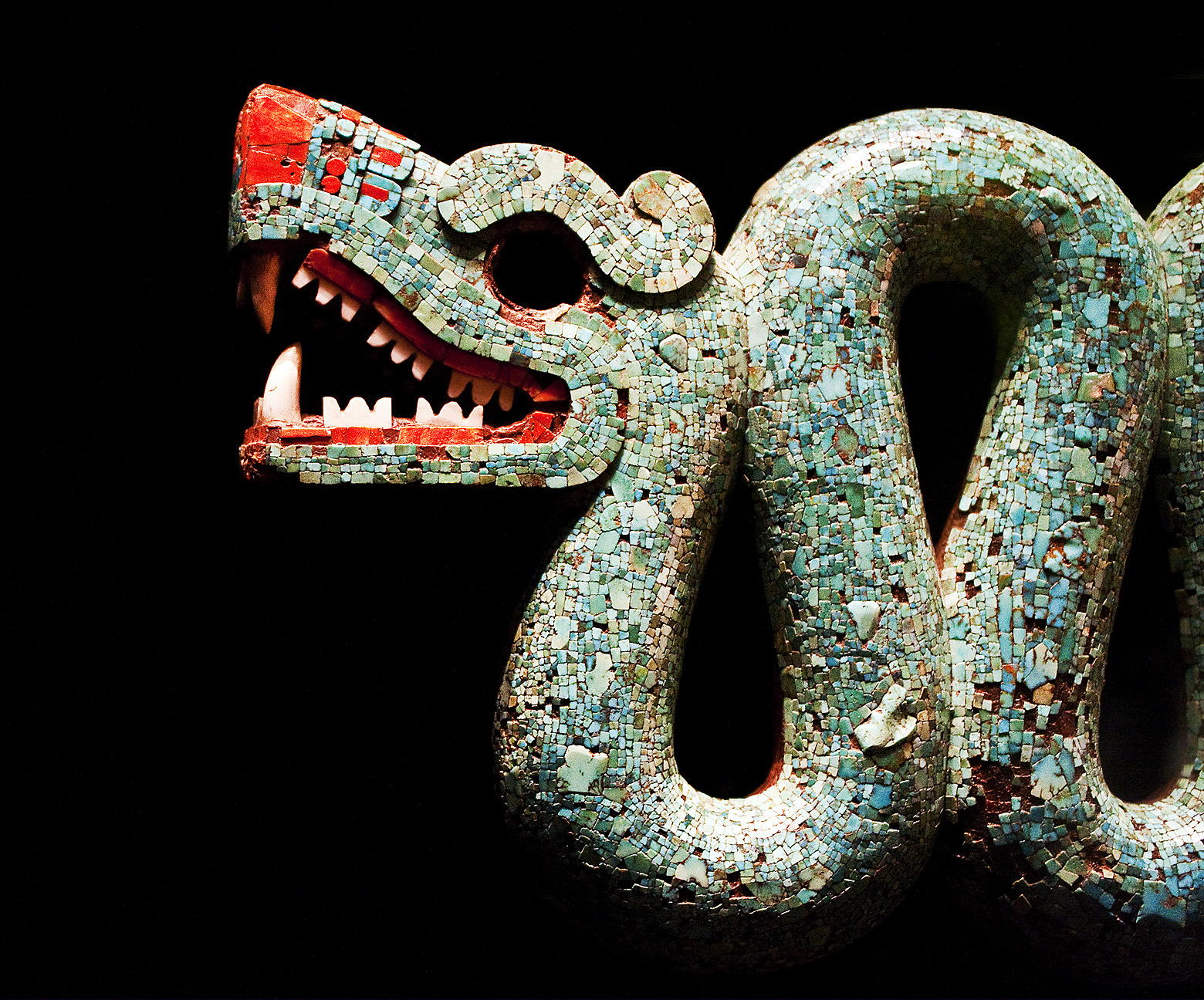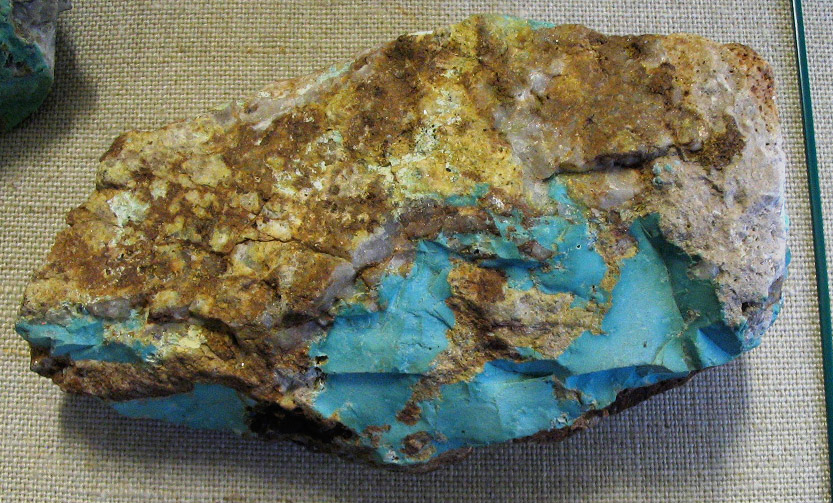|
Double-headed Serpent
The ''Double-headed serpent'' is an Aztec sculpture. It is a snake with two heads composed of mostly turquoise pieces applied to a wooden base. It came from Aztec Mexico and might have been worn or displayed in religious ceremonies. The mosaic is made of pieces of turquoise, spiny oyster shell and conch shell.Double-Headed Serpent , accessed September 2010 The sculpture is at the . Description [...More Info...] [...Related Items...] OR: [Wikipedia] [Google] [Baidu] |
Turquoise
Turquoise is an opaque, blue-to-green mineral that is a hydrated phosphate of copper and aluminium, with the chemical formula . It is rare and valuable in finer grades and has been prized as a gemstone and ornamental stone for thousands of years owing to its unique hue. Like most other opaque gems, turquoise has been devalued by the introduction of treatments, imitations and synthetics into the market. The robin's egg blue or sky blue color of the Persian turquoise mined near the modern city of Nishapur in Iran has been used as a guiding reference for evaluating turquoise quality. Names The word ''turquoise'' dates to the 17th century and is derived from the French ''turquois'' meaning "Turkish" because the mineral was first brought to Europe through the Ottoman Empire.Turquoise . minerals.usgs.gov Howe ... [...More Info...] [...Related Items...] OR: [Wikipedia] [Google] [Baidu] |
Spondylus Princeps
''Spondylus'' is a genus of bivalve molluscs, the only genus in the family Spondylidae.MolluscaBase (2019). MolluscaBase. Spondylus Linnaeus, 1758. Accessed through: World Register of Marine Species at: http://www.marinespecies.org/aphia.php?p=taxdetails&id=138518 on 2019-03-04 They are known in English as spiny oysters or thorny oysters (though they are not, in fact, true oysters). Description The many species of ''Spondylus'' vary considerably in appearance. They are grouped in the same superfamily as the scallops. They are not closely related to true oysters (family Ostreidae); however, they do share some habits such as cementing themselves to rocks rather than attaching themselves by a byssus. The two halves of their shells are joined with a ball-and-socket type of hinge, rather than with a toothed hinge as is more common in other bivalves. They also still retain vestigial anterior and posterior ''auricles'' ("ears", triangular shell flaps) along the hinge line, a char ... [...More Info...] [...Related Items...] OR: [Wikipedia] [Google] [Baidu] |
Turquoise
Turquoise is an opaque, blue-to-green mineral that is a hydrated phosphate of copper and aluminium, with the chemical formula . It is rare and valuable in finer grades and has been prized as a gemstone and ornamental stone for thousands of years owing to its unique hue. Like most other opaque gems, turquoise has been devalued by the introduction of treatments, imitations and synthetics into the market. The robin's egg blue or sky blue color of the Persian turquoise mined near the modern city of Nishapur in Iran has been used as a guiding reference for evaluating turquoise quality. Names The word ''turquoise'' dates to the 17th century and is derived from the French ''turquois'' meaning "Turkish" because the mineral was first brought to Europe through the Ottoman Empire.Turquoise . minerals.usgs.gov Howe ... [...More Info...] [...Related Items...] OR: [Wikipedia] [Google] [Baidu] |
Mixtec
The Mixtecs (), or Mixtecos, are indigenous Mesoamerican peoples of Mexico inhabiting the region known as La Mixteca of Oaxaca and Puebla as well as La Montaña Region and Costa Chica Regions of the state of Guerrero. The Mixtec Culture was the main Mixtec civilization, which lasted from around 1500 BC until being conquered by the Spanish in 1523. The Mixtec region is generally divided into three subregions based on geography: the Mixteca Alta (Upper Mixtec or Ñuu Savi Sukun), the Mixteca Baja (Lower Mixtec or Ñuu I'ni), and the Mixteca Costa (Coastal Mixtec or Ñuu Andivi). The Alta is drier with higher elevations, while the Baja is lower in elevation, hot but dry, and the Coasta also low in elevation but much more humid and tropical. The Alta has seen the most study by archaeologists, with evidence for human settlement going back to the Archaic and Early Formative periods. The first urbanized sites emerged here. Long considered to be part of the larger Mixteca region, ... [...More Info...] [...Related Items...] OR: [Wikipedia] [Google] [Baidu] |
Henry Christy
Henry Christy (26 July 1810 – 4 May 1865) was an English banker and collector, who left his substantial collections to the British Museum. Early life Christy was born at Kingston upon Thames, the second son of William Miller Christy of Woodbines, a Quaker banker who started out in hat manufacture with interests in Stockport, before becoming a financier. Trained to business by his father, Henry Christy became a partner in the house of Christy & Co. in Gracechurch Street, and succeeded his father as a director of the London Joint-Stock Bank. He was still a board member of the bank at the end of his life, despite other activities. Henry contributed to the success of the family firm, known as W. M. Christy & Sons Ltd. once his father took it over. Samples of textiles he brought home from the Ottoman Empire provided the idea for looped cotton towelling, taken up by his brother Richard, and amenable to mechanical manufacture with a technique devised by an employee. Christy also in ... [...More Info...] [...Related Items...] OR: [Wikipedia] [Google] [Baidu] |
Neil Macgregor
Robert Neil MacGregor (born 16 June 1946) is a British art historian and former museum director. He was editor of the ''The Burlington Magazine, Burlington Magazine'' from 1981 to 1987, then Director of the National Gallery, London, from 1987 to 2002, Director of the British Museum from 2002 to 2015, and founding director of the Humboldt Forum in Berlin until 2018. Biography Neil MacGregor was born in Glasgow to two medical doctors, Alexander and Anna MacGregor. He was educated at Glasgow Academy and then read modern languages at New College, Oxford, where he is now an honorary fellow. The period that followed was spent studying philosophy at the École Normale Supérieure in Paris (coinciding with the May 1968 events in France, events of May 1968), and as a law student at Edinburgh University, where he received the Green Prize. Despite being called to the bar in 1972, MacGregor next decided to take an art history degree. The following year, on a Courtauld Institute of Art, C ... [...More Info...] [...Related Items...] OR: [Wikipedia] [Google] [Baidu] |
Smallpox
Smallpox was an infectious disease caused by variola virus (often called smallpox virus) which belongs to the genus Orthopoxvirus. The last naturally occurring case was diagnosed in October 1977, and the World Health Organization (WHO) certified the global eradication of the disease in 1980, making it the only human disease to be eradicated. The initial symptoms of the disease included fever and vomiting. This was followed by formation of ulcers in the mouth and a skin rash. Over a number of days, the skin rash turned into the characteristic fluid-filled blisters with a dent in the center. The bumps then scabbed over and fell off, leaving scars. The disease was spread between people or via contaminated objects. Prevention was achieved mainly through the smallpox vaccine. Once the disease had developed, certain antiviral medication may have helped. The risk of death was about 30%, with higher rates among babies. Often, those who survived had extensive scarring of their ... [...More Info...] [...Related Items...] OR: [Wikipedia] [Google] [Baidu] |
Tenochtitlan
, ; es, Tenochtitlan also known as Mexico-Tenochtitlan, ; es, México-Tenochtitlan was a large Mexican in what is now the historic center of Mexico City. The exact date of the founding of the city is unclear. The date 13 March 1325 was chosen in 1925 to celebrate the 600th anniversary of the city. The city was built on an island in what was then Lake Texcoco in the Valley of Mexico. The city was the capital of the expanding Aztec Empire in the 15th century until it was captured by the Spanish in 1521. At its peak, it was the largest city in the pre-Columbian Americas. It subsequently became a '' cabecera'' of the Viceroyalty of New Spain. Today, the ruins of are in the historic center of the Mexican capital. The World Heritage Site of contains what remains of the geography (water, boats, floating gardens) of the Mexica capital. was one of two Mexica (city-states or polities) on the island, the other being . The city is located in modern-day Mexico City. Etymolo ... [...More Info...] [...Related Items...] OR: [Wikipedia] [Google] [Baidu] |
Quetzalcoatl
Quetzalcoatl (, ; Spanish: ''Quetzalcóatl'' ; nci-IPA, Quetzalcōātl, ket͡saɬˈkoːaːt͡ɬ (Modern Nahuatl pronunciation), in honorific form: ''Quetzalcōātzin'') is a deity in Aztec culture and literature whose name comes from the Nahuatl language and means "Precious serpent" or " Quetzal-feathered Serpent". In the 17th century, Ixtlilxóchitl, a descendant of Aztec royalty and historian of the Nahua people, wrote, "Quetzalcoatl, in its literal sense, means 'serpent of precious feathers', but in the allegorical sense, 'wisest of men'." Among the Aztecs, whose beliefs are the best-documented in the historical sources, Quetzalcoatl was related to gods of the wind, of the planet Venus, of the dawn, of merchants and of arts, crafts and knowledge. He was also the patron god of the Aztec priesthood, of learning and knowledge. Quetzalcoatl was one of several important gods in the Aztec pantheon, along with the gods Tlaloc, Tezcatlipoca and Huitzilopochtli. Two other gods re ... [...More Info...] [...Related Items...] OR: [Wikipedia] [Google] [Baidu] |
Moctezuma II
Moctezuma Xocoyotzin ( – 29 June 1520; oteːkˈsoːmaḁ ʃoːkoˈjoːt͡sĩn̥), nci-IPA, Motēuczōmah Xōcoyōtzin, moteːkʷˈsoːma ʃoːkoˈjoːtsin variant spellings include Motewksomah, Motecuhzomatzin, Montezuma, Moteuczoma, Motecuhzoma, Motēuczōmah, Muteczuma, and referred to retroactively in European sources as Moctezuma II, was the ninth Emperor of the Aztec Empire (also known as Mexica Empire), reigning from 1502 or 1503 to 1520. Through his marriage with queen Tlapalizquixochtzin of Ecatepec, one of his two wives, he was also king consort of that ''altepetl''. The first contact between the indigenous civilizations of Mesoamerica and Europeans took place during his reign, and he was killed during the initial stages of the Spanish conquest of the Aztec Empire, when conquistador Hernán Cortés and his men fought to take over the Aztec capital Tenochtitlan. During his reign, the Aztec Empire reached its greatest size. Through warfare, Moctezuma expanded the ter ... [...More Info...] [...Related Items...] OR: [Wikipedia] [Google] [Baidu] |
Hernán Cortés
Hernán Cortés de Monroy y Pizarro Altamirano, 1st Marquess of the Valley of Oaxaca (; ; 1485 – December 2, 1547) was a Spanish ''conquistador'' who led an expedition that caused the fall of the Aztec Empire and brought large portions of what is now mainland Mexico under the rule of the King of Castile in the early 16th century. Cortés was part of the generation of Spanish explorers and conquistadors who began the first phase of the Spanish colonization of the Americas. Born in Medellín, Spain, to a family of lesser nobility, Cortés chose to pursue adventure and riches in the New World. He went to Hispaniola and later to Cuba, where he received an '' encomienda'' (the right to the labor of certain subjects). For a short time, he served as '' alcalde'' (magistrate) of the second Spanish town founded on the island. In 1519, he was elected captain of the third expedition to the mainland, which he partly funded. His enmity with the Governor of Cuba, Diego Velázquez de Cu ... [...More Info...] [...Related Items...] OR: [Wikipedia] [Google] [Baidu] |





.jpg)


